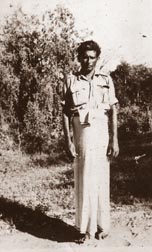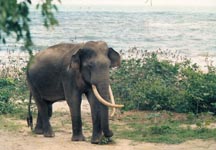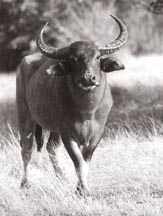The life and times of a Wildlife man is unpredictable. Every day is an adventure into the unknown. Reminiscing over 35 of the best years of my life, the mind awakens memories and nostalgia of the many trails trod as a protector of wildlife and the environment.
by E. Desmond White, Former Park Warden, Yala Sunday Observer Sep 1 2002
|
|
My first appointment as a trainee Game Ranger was to Yala (Palatupana H.Q.), back in 1957, on April fools' day. I travelled to Tissamaharama the previous day and spent the night at the Rest-house which consisted of two rooms. That night I shared my room with a travelling businessman, who on the following morning, gave me a lift to the Post Office, situated on the Kirinda road, now relegated to the status of a Sub. P.O. This was to be our meeting point with the Wildlife personnel from Palatupana and it was here that I met the lanky A. B. Fernando, similarly reporting for duty. Deptl. jeep No. C.N-3624 met us at the Post Office and took us to Palatupana. Incidentally, at that time the entire Department had only three jeeps, one stationed at Yala, one at Wilpattu and the other at H.Q. Colombo, for use of the director.
Our immediate boss was the Div. Game Ranger, the late G. N. Q. de Silva and his assistants were the late Peter Jayawardene and D. T. S. Seneviratne. G.N.Q., Peter and Percy as they were fondly known were our instructors. G.N.Q. and Peter were ex. Army officers, the former ramrod straight, was a strict disciplinarian and Peter, a tough man and a superb shot.
|
|
My contemporaries were Shirley Perera, A. B. Fernando and the late M. F. M. Izzadeen. For accommodation we had to share two cubicles with hardly any space to move about once the 'donkey beds' were placed. We had to get together and prepare our meals, and this too served as part of our training.
Our training comprised trips on foot into the jungles, routine office work, study of relevant ordinances and laws and firearms practice. A lot of effort went into changing us from ordinary lads to jungle men, and our instructor on these field trips was late W. L. A. Andiris, a veteran of the Yala jungles. Up at the crack of dawn, warmed up with a cup of plain tea and armed with a short wooden staff, we would easily walk 8 to 10 miles on any given day, studying animal behaviour, animal tracks and the jungle in general. We would traverse varied terrain and learn to crawl, walk and climb quickly and noiselessly under the guidance and expertise of Andiris. After these jungle trips we usually returned to base around 10.30 a.m. and only then had the pleasure of enjoying a solid meal. Incidentally, Andiris was a Game Guard in the Dept. at that time. His brother-in-law. A. W. Siridias was also an employee in the Dept. and was one of the original settlers at Palatupana (Godekalapuwa happens to be the name of the place now referred to as Palatupana. Palatupana is the place where the salt pans are situated. According to Siridias, Andiris and members of his family had been originally resident at Andunoruwa (close to Menikganga at Yala, Block I of the Park) and maybe for sustenance cultivated paddy in Yala-wela (beyond Menikganga, of what is today Block II of the Park).
|
|
According to available evidence the area between Yala and Katagamuwa, bordering the Menikganga had been inhabited during this period. Past Yala on the Katagamuwa road and before Komawewa there are ruins of a dagoba with a few stone pillars around suggesting a Buddhist temple. Beyond this is Kotabendiwewa with a 'murunga' grove around the place. It is rumoured that a cripple or 'atha kota' living with these people at that time had sought the help of a few others to build this 'wewa' and when their co-operation was not forthcoming, he on his own 'single handed' had constructed this tank and hence the name 'Kota-bendi wewa'.
Sites by the Menikganga, namely Paranatotupola (Yala), Kosgasmankada, Narangastota, Agiliyagastota, Thalgasmankada, Warahana, Rugamtota, Pahalahentota, and tanks such as Komawewa, Kotabendiwewa, Korawakwewa, Katagamuwewa suggest human habitation and activities in this area. To date a section of land in the Katagamuwa Sanctuary is being cultivated with paddy by a private party. Ruins of a dagoba and the 'Nandimithra sohona' or tomb are also found in the Katagamuwa area. Nandimithra is said to be a warrior of king Dutugamunu.
Andiris and his family, including Reginahamy his sister, had subsequently moved to Godekalapuwa around the year 1905. Thereafter Andiris had made Godekalapuwa his home and the watle and daub house he occupied with his family still stands there and is now occupied by Lilynona his niece, daughter of Reginahamy. Andiris together with his brothers and cousins had been cultivating paddy in an allotment of about 15 acres of land in Godekalapuwa. When we joined the Dept. in 1957 a small section of this land had been cultivated and a battery-operated electric fence had been erected by the Dept. on an experimental basis, to ward off marauding wild animals. Siridias, the only other resident at Godekalapuwa now lives there in a wattle and daub house, once employed in the Dept., now leading a retired life.
Henry Englebrecht was the first Camp Warden of the Ruhuna National Park (1907-1928). During the period of about 20 years that Englebrecht operated in the Yala area, it is said that in the course of his duties he had to cover the Panama, Okanda, Kumana, Yala, Palatupana. Tissamaharama areas finally arriving at Hambantota, where he received his pay packet from the Government authority and also bought his provisions and other necessities, returning along the same route. His mode of transport had been a double bullock cart, with a couple of spare bulls trailing behind. Being a lone man with human instincts he had left tangible evidence indicating that he did sow his wild oats on his trips up and down his domain. There is to this day a herd of neat cattle, now turned wild, seen in Block II of the Park, which people say are the remnants of Englebrecht's large - humped bullocks having mated with cows belonging to the Kumana village herd.
Henry Englebrecht had a son named Harry Englebrecht, who had been a Game Guard in the Dept. He had been subsequently discharged from the Dept. and I met him thereafter at Tissamaharama and Anuradhapura and has not been heard of since. It is rumoured that Englebrecht (Snr) used to give his son a shotgun and just one cartridge to shoot and animal for the pot. Failure to do so would result in a horse - whipping and this had made him an excellent stalker and a top marksman. It is a well-known fact that some of the descendants and relatives of the Englebrechts are residents in Tissamaharama and Godekalapuwa, while some others are employed in the Dept., while still some others have since retired from service or passed away. Englebrecht's grave with a tombstone is found in the graveyard close to the Hambantota town.
Menika was considered the patriarch of the Kumana village and was an interesting character in many ways. Whilst at Yala, I used to meet him on my official trips to Kumana. He was a regular user of cannabis and for his use grew the weed in his home plot. He had many occasional visitors from high positions both in the state as well as the private sector, who shared and enjoyed his hospitality, under his humble thatched roof and cow-dung smeared floor. No doubt Menika in return received many favours from his guests, some of them far greater than the value of money.
Menika had a family of about 10 children and in the course of time all his sons were able to join the Wildlife Department whilst his attractive daughters married Wildlife Department employees. Menika met with his death after being stung by a cobra in Block II of the Park. He had been on his way home on foot from Yala to Kumana, accompanied by Game Guard A. W. Hendrikappuhamy, who was married from Kumana.
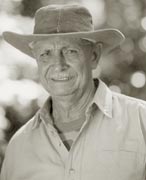
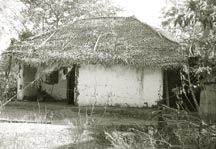
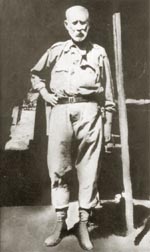
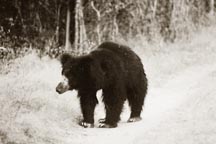 The
late Mr. A. S. A. Packeer, a pioneer in the Wildlife Dept., began his
career as a qualified teacher on the staff of St. Thomas' College,
Gurutalawa. He joined the Forest Dept. as a Junior Asst. Conservator of
Forests (Fauna and Flora) in the year 1948 and branched off to the Dept.
of Wildlife during its formative year of 1950, in the capacity of Asst.
Warden. A man of generous proportions, humane and kind to his
subordinates, he made his silent contributions to the Dept., mainly
regarding legal work and earned himself the title of 'Legal Eagle' of
the Dept. He passed away in July 2001 relatively unheard of and unsung,
whilst in retirement.
The
late Mr. A. S. A. Packeer, a pioneer in the Wildlife Dept., began his
career as a qualified teacher on the staff of St. Thomas' College,
Gurutalawa. He joined the Forest Dept. as a Junior Asst. Conservator of
Forests (Fauna and Flora) in the year 1948 and branched off to the Dept.
of Wildlife during its formative year of 1950, in the capacity of Asst.
Warden. A man of generous proportions, humane and kind to his
subordinates, he made his silent contributions to the Dept., mainly
regarding legal work and earned himself the title of 'Legal Eagle' of
the Dept. He passed away in July 2001 relatively unheard of and unsung,
whilst in retirement. 